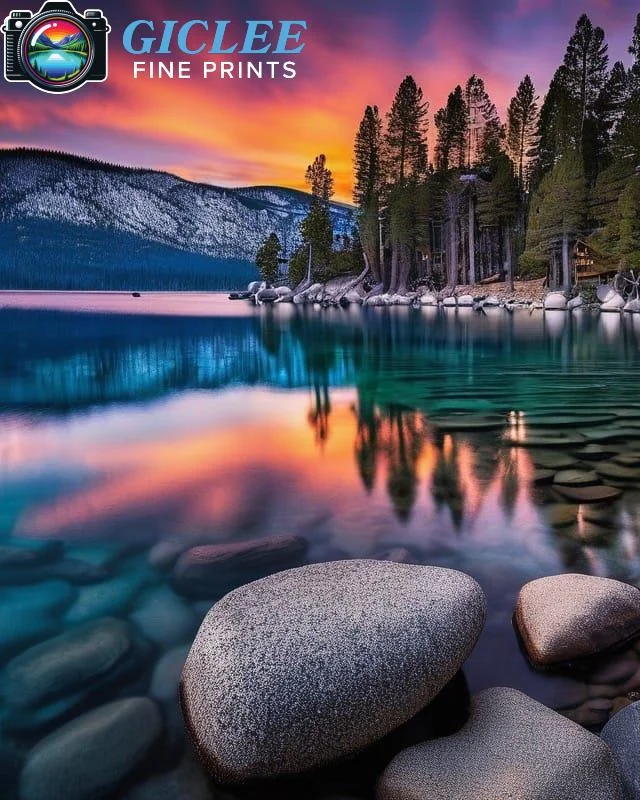
When it comes to showcasing artwork or photography, both art printing and canvas printing offer unique advantages, but they serve different purposes and aesthetics. Understanding the key distinctions between these two printing methods is essential to selecting the right option for your needs, whether you’re an artist, photographer, or art collector. At Giclee Fine Prints, we specialize in both art printing and canvas printing, ensuring that each piece is represented with the highest quality possible.
Definition and Materials
The primary distinction between art printing and canvas printing lies in the materials used and how the artwork is displayed.
Art Printing:
- Fine Art Paper: Art printing typically involves printing artwork or photography on fine art paper. This can include various types of premium paper such as smooth matte, textured paper, or glossy finishes. These papers are often archival quality, designed to preserve the image’s color and detail for decades.
- Photographic Paper: Art prints can also be produced on high-quality photographic paper for images that require sharpness and detail, such as photo prints or intricate illustrations.
- Framed or Unframed: Art prints are often framed behind glass or acrylic for protection and presentation. Framing adds a layer of polish and sophistication to the piece, making it ideal for more formal or traditional displays.
Canvas Printing:
- Canvas Fabric: Canvas printing involves printing directly onto canvas, typically made from cotton, polyester, or a blend of the two. The canvas is then stretched over wooden stretcher bars to create a durable, frameless display.
- Textured Surface: Unlike smooth paper, canvas has a textured surface that mimics the look and feel of a painting. This gives the artwork a more tactile, organic appearance.
- Gallery Wrap: Canvas prints are often gallery-wrapped, meaning the image extends around the edges of the frame, creating a modern, frameless look that is ready to hang without additional framing.
Best For:
- Art Printing: Ideal for photographers and artists who want to showcase fine details and vibrant colors on premium fine art paper or photo paper.
- Canvas Printing: Perfect for large-format art or photography where a textured, frameless presentation is desired, offering a more contemporary or gallery-style display.
Visual Appearance and Texture
The overall look and texture of the printed piece is another key distinction between art printing and canvas printing.
Art Printing:
- Smooth and Detailed: Art prints on fine art paper or photographic paper offer a smooth surface that preserves every fine detail and sharp line in the image. This makes art printing ideal for work where precision, sharpness, and detail are essential, such as architectural photography, fine art reproductions, or graphic designs.
- Color Vibrancy: The smoothness of fine art paper allows ink to sit evenly on the surface, resulting in vibrant, saturated colors. This is particularly beneficial for photography prints or digital art that requires true-to-life color reproduction.
Canvas Printing:
- Textured and Artistic: The textured surface of canvas adds depth and a painterly quality to the image, softening fine details but creating a more artistic, tactile feel. This texture can enhance certain types of artwork, such as landscapes, portraits, or abstract paintings, where the canvas texture complements the style.
- Muted Colors: While canvas prints can still achieve vibrant colors, the textured surface may slightly mute or soften the colors compared to prints on smooth paper. This gives the artwork a more organic, hand-painted feel rather than a crisp photographic look.
Best For:
- Art Printing: Ideal for photographers, illustrators, or artists who want their work to showcase sharp details and vibrant colors on a smooth surface.
- Canvas Printing: Best suited for artworks where texture enhances the overall aesthetic, such as paintings, portraits, or abstract art.

Durability and Longevity
Both art prints and canvas prints can be highly durable, but the materials used play a role in how well they stand the test of time.
Art Printing:
- Archival Quality Paper: High-quality art prints are often produced on archival fine art paper, designed to last for decades without fading or yellowing. When combined with pigment-based inks, these prints can maintain their color integrity and detail for over 100 years if properly cared for.
- Framing for Protection: Art prints are typically framed under glass or acrylic, which helps protect the print from environmental factors like moisture, dust, and UV light. This added layer of protection ensures the longevity of the print, especially for high-end artwork.
Canvas Printing:
- Durable Canvas Material: Canvas prints are known for their durability, especially when printed on high-quality, thick canvas. The canvas fabric is resistant to wear and tear, making it ideal for long-term display, even in high-traffic areas.
- Fade-Resistant Inks: Canvas prints created using pigment-based inks are highly resistant to fading, even when exposed to sunlight. This makes canvas an excellent option for art that will be displayed in well-lit rooms or commercial spaces.
- No Need for Framing: Unlike art prints that require framing for protection, canvas prints are often displayed without frames, thanks to their sturdy construction and gallery wrap technique. This reduces the need for additional materials and makes the artwork ready to hang.
Best For:
- Art Printing: Great for fine art or photography that will be framed for long-term protection and display in controlled environments.
- Canvas Printing: Ideal for more durable, large-format displays in busy areas or spaces with higher exposure to sunlight.
Presentation and Display Options
The way you present your artwork or photography can vary significantly depending on whether you choose art printing or canvas printing.
Art Printing:
- Framed Display: Art prints are most commonly displayed in frames, which can be customized to match the artwork or the decor of the space. Framing enhances the artwork’s presentation and adds a professional, polished look. Additionally, framed art prints can be matted, which adds depth and draws attention to the artwork itself.
- Variety of Paper Finishes: Art prints can be produced on various types of paper, such as glossy, matte, or textured finishes. These options allow for flexibility in presentation and cater to different aesthetic preferences.
- Easily Transportable: Due to their lightweight nature, art prints are easy to transport, store, or ship. This makes them a popular choice for art shows, galleries, and online sales.
Canvas Printing:
- Gallery Wrap: One of the main advantages of canvas printing is the gallery wrap, where the image is stretched around the edges of the canvas, creating a frameless look. This modern, minimalist presentation is perfect for contemporary spaces and does not require additional framing.
- Framed Canvas: Although canvas prints are often displayed frameless, they can also be framed for a more traditional or decorative look. Floating frames are a popular option for canvas prints, giving the illusion that the artwork is floating within the frame.
- Three-Dimensional Presence: Because canvas prints have depth, they stand out from the wall, giving the artwork a three-dimensional presence. This makes them ideal for large-format works or pieces that are meant to make a statement.
Best For:
- Art Printing: Perfect for those who prefer traditional framed art that can be customized with different matting and framing options.
- Canvas Printing: Ideal for modern, frameless displays where the artwork itself is the main focal point without the need for frames.

Cost and Affordability
Cost can be an important factor when deciding between art printing and canvas printing, as they each come with different price points based on the materials and printing techniques used.
Art Printing:
- Affordable Options: Art prints can range from affordable to high-end, depending on the type of paper, size, and printing method used. Prints on standard photo paper tend to be more affordable, while those on archival fine art paper come with a higher price due to the quality and longevity of the materials.
- Framing Costs: While art prints themselves can be affordable, framing adds an additional cost. High-quality frames, mats, and protective glass can significantly increase the overall price, making art prints more expensive to display.
Canvas Printing:
- Higher Initial Cost: Canvas prints are generally more expensive than unframed art prints due to the cost of canvas materials, stretching, and the gallery wrap technique. However, the fact that they don’t require framing may offset the higher upfront cost.
- Ready to Hang: Since canvas prints don’t typically require additional framing, they offer a cost-effective solution for those looking for a ready-to-hang piece. This eliminates the need for custom frames and reduces overall costs.
Best For:
- Art Printing: Ideal for buyers looking for affordable, high-quality prints with the option to customize framing and presentation.
- Canvas Printing: Best for those who prefer a ready-to-hang, frameless solution and are willing to invest in a more durable, long-lasting piece.
Contact Us
Our address is: 3816 Pioneer Trail Ste #3, South Lake Tahoe, CA 96150
Email: Info@gicleefineprints.com
FAQs
Art printing typically refers to printing on fine art paper or photographic paper, offering sharp details and vibrant colors, often framed for display. Canvas printing involves printing on a textured canvas that is stretched over a frame, providing a more tactile, gallery-style presentation without the need for additional framing.
Art printing is generally better for photography because it preserves fine details and vibrant colors on smooth paper. However, canvas printing can be a great option for larger prints or where a more artistic, textured look is desired.
Yes, canvas prints can be just as long-lasting as art prints, especially when using archival-quality canvas and pigment-based inks. Both printing methods can produce fade-resistant, durable prints that last for decades with proper care.


